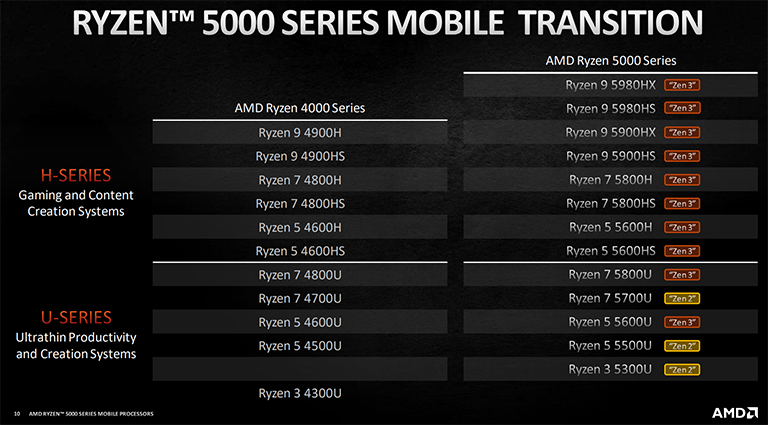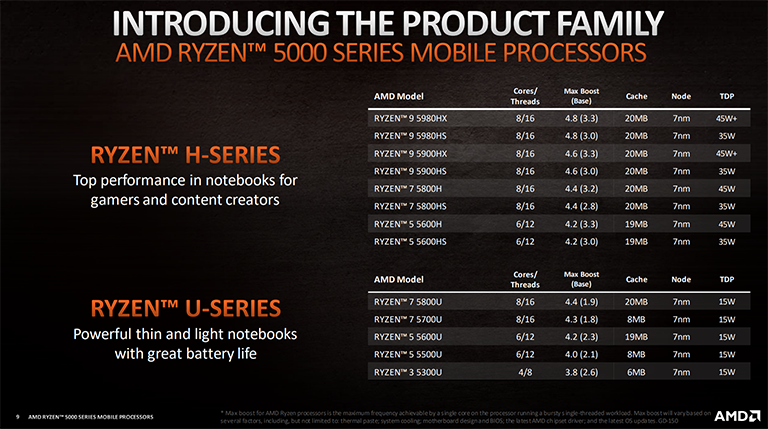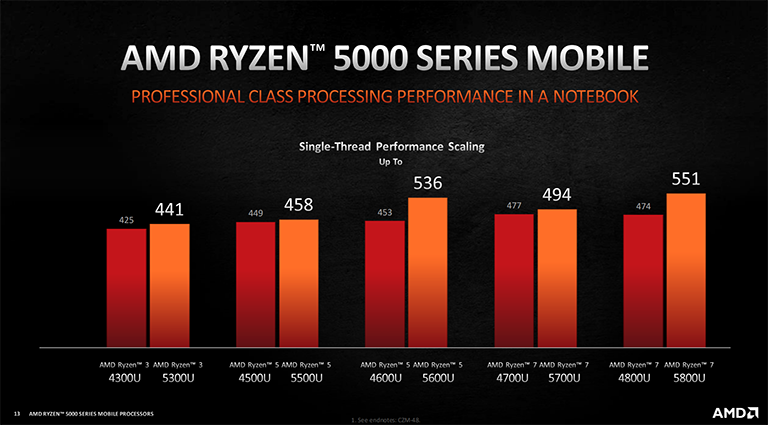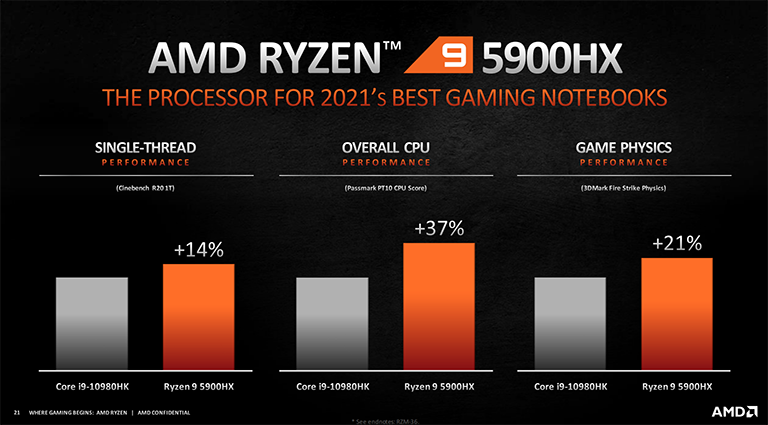After a busy November and December in the desktop CPU and GPU space, AMD starts off 2021 with renewed focus on mobile processors.
The virtual CES 2021 is the backdrop for announcing the AMD Ryzen 5000 Series mobile chips codenamed Cezanne.
AMD CEO and President, Lisa Su, announced 13 new processors that build on the momentum created by Ryzen 4000 Series Mobile (Renoir) from March last year.
The 13-chip stack is split into two established camps. Five models are designated U-Series, meaning they're designed for thin-and-light laptops which usually accommodate 15W TDP chips. The further eight are from the performance H-series family (35W+), primed for high-performance gaming and content creator laptops that usually ship with a discrete graphics card.
A handy comparison slide spells out how AMD sees the incumbent 4000 Mobile Series give way to the new, improved 5000 Mobile. Before we get into the nitty-gritty of what is new under the hood, it's worth understanding that three of the 13 new chips continue to be based on the existing Zen 2 CPU architecture. AMD's reasoning rests with certain markets requiring the easiest possible transition from one family to the next.
Peeking at high-level speeds and feeds reveals AMD largely follows the same CPU core-and-thread philosophy as present Ryzen 4000 Mobile solutions. This means Ryzen 7 and 9 carry eight cores and 16 threads, Ryzen 5 is equipped with 6C12T and Ryzen 3 matches the present PRO model by having 4C8T.
So what are the differences, you may ask? The main one is that the majority of chips - 10 out of 13 - use the latest Zen 3 architecture, which you can read all about here. In a nutshell, it provides an average 19 per cent IPC uplift over Zen 2 at the same frequency. These Zen 3 parts have double the L3 cache compared to their direct predecessors. Like their desktop counterparts, improved yields and processes lend themselves to higher frequencies on top of that IPC uplift, and always-on Collaborative Processor Performance Control (CPPC) technology keeps speeds high.
The following table lists the new processors, emboldened, alongside 4000 Series Mobile chips.
Mobile AMD Ryzen product range | ||||||||
|---|---|---|---|---|---|---|---|---|
| Model |
Cores / Threads
|
TDP
|
L3 Cache
|
Base Clock
|
Turbo Clock
|
Process
|
Arch
|
GPU
|
AMD Ryzen 9 | ||||||||
| Ryzen 9 5980HX |
8 / 16
|
45W+
|
16MB
|
3.3GHz
|
4.8GHz
|
7nm
|
Zen 3
|
Vega
|
| Ryzen 9 5980HS |
8 / 16
|
35W
|
16MB
|
3.0GHz
|
4.8Hz
|
7nm
|
Zen 3
|
Vega
|
| Ryzen 9 5900HX |
8 / 16
|
45W+
|
16MB
|
3.3GHz
|
4.6GHz
|
7nm
|
Zen 3
|
Vega
|
Ryzen 9 5900HS |
8 / 16
|
35W
|
16MB
|
3.0GHz
|
4.6GHz
|
7nm
|
Zen 3
|
Vega
|
| Ryzen 9 4900H | 8 / 16 |
35W+ |
8MB |
3.3GHz |
4.4GHz |
7nm |
Zen 2 |
Vega |
| Ryzen 9 4900HS | 8 / 16 |
35W |
8MB |
3.0GHz |
4.3GHz |
7nm |
Zen 2 |
Vega |
AMD Ryzen 7 | ||||||||
| Ryzen 7 5800H |
8 / 16
|
45W
|
16MB
|
3.2GHz
|
4.4GHz
|
7nm
|
Zen 3
|
Vega
|
Ryzen 7 5800HS |
8 / 16
|
35W
|
16MB
|
2.8GHz
|
4.4GHz
|
7nm
|
Zen 3
|
Vega
|
| Ryzen 7 5800U |
8 / 16
|
15W
|
16MB
|
1.9GHz
|
4.4GHz
|
7nm
|
Zen 3
|
Vega
|
| Ryzen 7 5700U |
8 / 16
|
15W
|
8MB
|
1.8GHz
|
4.3GHz
|
7nm
|
Zen 2
|
Vega
|
| Ryzen 7 4800H |
8 / 16
|
35W+
|
8MB
|
2.9GHz
|
4.2GHz
|
7nm
|
Zen 2
|
Vega
|
| Ryzen 7 4800HS |
8 / 16
|
35W
|
8MB
|
2.9GHz
|
4.2GHz
|
7nm
|
Zen 2
|
Vega
|
| Ryzen 7 4800U |
8 / 16
|
15W
|
8MB
|
1.8GHz
|
4.2GHz
|
7nm
|
Zen 2
|
Vega
|
| Ryzen 7 4700U |
8 / 8
|
15W
|
8MB
|
2.0GHz
|
4.1GHz
|
7nm
|
Zen
|
Vega
|
AMD Ryzen 5 | ||||||||
| Ryzen 5 5600H |
6 / 12
|
45W
|
16MB
|
3.3GHz
|
4.2GHz
|
7nm
|
Zen 3
|
Vega
|
Ryzen 5 5600HS |
6 / 12
|
35W
|
16MB
|
3.0GHz
|
4.2GHz
|
7nm
|
Zen 3
|
Vega
|
| Ryzen 5 5600U |
6 / 12
|
15W
|
16MB
|
2.3GHz
|
4.2GHz
|
7nm
|
Zen 3
|
Vega
|
| Ryzen 5 5500U |
6 / 12
|
15W
|
8MB
|
2.1GHz
|
4.0GHz
|
7nm
|
Zen 2
|
Vega
|
| Ryzen 5 4600H |
6 / 12
|
35W+
|
8MB
|
3.0GHz
|
4.0GHz
|
7nm
|
Zen 2
|
Vega
|
| Ryzen 5 4600HS |
6 / 12
|
35W
|
8MB
|
3.0GHz
|
4.0GHz
|
7nm
|
Zen 2
|
Vega
|
| Ryzen 5 4600U |
6 / 12
|
15W
|
8MB
|
2.1GHz
|
4.0GHz
|
7nm
|
Zen 2
|
Vega
|
| Ryzen 5 4500U |
6 / 6
|
15W
|
8MB
|
2.3GHz
|
4.0GHz
|
7m
|
Zen 2
|
Vega
|
AMD Ryzen 3 | ||||||||
| Ryzen 3 5300U |
4 / 8
|
15W
|
4MB
|
2.6GHz
|
3.8GHz
|
7nm
|
Zen 2
|
Vega
|
Ryzen 3 4300U |
4 / 4
|
15W
|
4MB
|
2.7GHz
|
3.7GHz
|
7nm
|
Zen 2
|
Vega
|
The majority of the performance uplift is on the CPU side, clearly, as AMD continues to use the older Vega architecture for the baked-in graphics. It's surprising not to see RDNA2 make an appearance in mobile when rival Intel has focussed on significantly improving its graphics capability. Countering inferences on a lack of innovation, Lisa Su mentioned that RDNA2 graphics will be coming to laptops this year.
Ryzen 5000 Mobile U-Series
Drilling down, the premier U-Series 15W chip is the Ryzen 7 5800U. Understanding the combination of higher IPC and CPU core frequency means it will be 10-20 per cent faster than last year's Ryzen 7 4800U. AMD provided a couple of slides pertaining to productivity and professional-class performance. The increase isn't as spectacular as the last jump because AMD keeps to the same maximum 8C16T processing. Rather more importantly, AMD reckons its top 15W solution is better at productivity than Intel's Tiger Lake Core i7-1165G7. It should be, too, as it has double the cores and threads. Battery life increases by an hour or two, as well. Interestingly, AMD doesn't share any purported IGP gaming benchmarks.
Other U-Series chips replicate the CPU-side improvement, and it's good to see SMT everywhere. Think of them as incremental improvements over last year's offerings. Laptop OEM partners will naturally switch out to Ryzen 5000 Mobile with the minimum of fuss.
Ryzen 5000 Mobile H-Series
AMD previously used the HS branding for high-performance mobile processors considered best in class. Ryzen 5000 Mobile duly has a couple of those models, but the top dogs now, primed for no-compromise laptops, are the new HX. Multiplier unlocked for maximum OEM implementation flexibility, this HX category sets a new bar for performance.
The Ryzen 9 5980HX and 5900HX will go head to head against the best Intel 11th Gen Tiger Lake chips for inclusion in the premier gaming laptops of 2021.
As a wrap, AMD's mobile processor portfolio is expanded by a slew of processors mainly based on Zen 3 CPU technology. Offering a number of options for ultraportable and high-performance laptops in 2021, expect up to 20 per cent more CPU oomph than last year's premier solutions. It's rather disappointing AMD hasn't integrated the latest RDNA2 architecture for the graphics portion, particularly for thin-and-light laptops with no space for discrete cards, so a mid-year refresh may well be on the cards.
Looking for a new laptop in 2021? The choice between Intel Tiger Lake and AMD Cezanne becomes more interesting than ever. Add to that the complete disruption caused by Apple's electric M1 processor and we have the makings of some serious competition. The winner is you, the consumer, as all three companies have compelling technology.
As enthusiasts and coming off the announcements at CES, which would you choose? Intel, AMD, or, dare we say, Apple in the mobile space? Let us know your thoughts in the forums.











